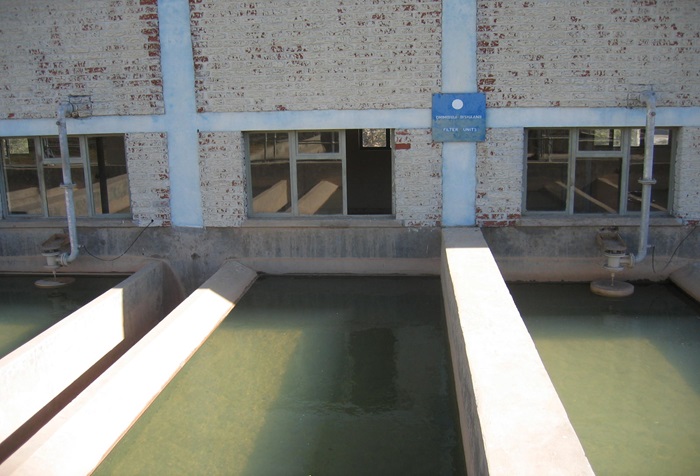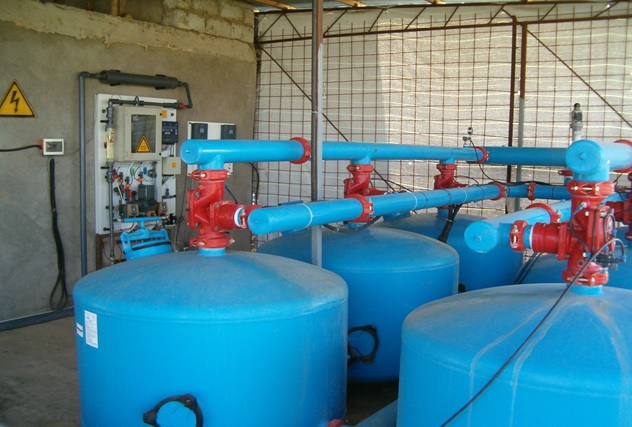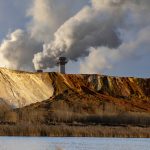Rapid sand filtration
In urban areas the slow sand filter simply occupies too much space. Therefore, rapid sand filtration has been developed and has become the most common type of filter for treating municipal water supplies.
Typical filtration rate for rapid sand filter is 5 m/h, compared to 0.15 m/h in slow sand filtration.
The area required for sand filtration can be calculated using the following equation:
A = Q/V
Where,
A is the filter area in square meters (m2)
Q – Inlet water flow rate in m3/h
V – filtration velocity in m/h
We can use this equation to compare the required filtration area between slow sand filtration and rapid sand filtration:
Assuming a water supply requirement of 24,000 m3/day
The area required for slow sand filtration:
A= Q/V = (1,000 m3/h) / (0.15 m/h) = 6,666 m2
Area required for rapid sand filtration:
A= Q/V = (1,000 m3/h) / (5 m/h) = only 200 m2
Rapid sand filtration is a rather complex process – it is demanding and expensive in design and operation and requires well-trained personnel for monitoring, operation and maintenance.
It can provide safe drinking water only in combination with pre and post treatment measures. A pre-filtration process of coagulation-flocculation is usually required, as well as disinfection post-treatment.
In rapid sand filtration the filtration occurs due to the depth of the filter, where the principle mechanisms that act in the filtration process are straining, sedimentation and adsorption
TYPES OF RAPID SAND FILTERS
Gravity filters
Filtration takes place in open, usually concrete tanks. This type of filters operate with atmospheric pressure.
Filtration rate between is 4 and 8 m/h.
Pressure filters
In pressure filters, the media is enclosed in a pressure vessel, usually steel tank, and the filters operate under pressure that is higher than atmospheric pressure.
Filtration rate is between 5 and 25 m/h.
Types of media used in rapid sand filtration
Rapid sand filters can be classified according to the number of types of media used.
- Single media – fine grain or coarse grain are used: Sand or anthracite (coal).
- Dual media – usually sand and anthracite.
- Multimedia – usually garnet, sand and anthracite.
|
Media |
Uniformity coefficient | Effective size | Density |
Layer depth in filter |
|
Anthracite |
<1,7 | 0,6 – 1,6 mm | >1,4 | 0.4 – 0.6 m |
|
Sand |
<1,7 |
0,35 – 0,65 mm |
>2,5 |
0.15 – 0.2 m |
| Garnet | <2,2 | 0,18 – 0,60 mm | >3,8 |
0.05 – 0.075 m |
Due to their different gravities, the different media always re-arrange in the same order, even after backwashing the filter, where the heavier, but finer media layer is always at the bottom. This allows for higher capacity to retain impurities.
Example of a basic design of rapid sand filtration
A municipality wishes to install rapid sand filters.
The design filtration rate is 5 m/h.
The design flow rate of the filter is 1,260 m3/h
Maximum required area per filter – 50 m2.
- Design filter size and number of filters required.
- Calculate the filtration rate.
Solution
A = Q / (a*V), where “a” is the ratio between the number of operation hours per day divided by 24 hours.
A/n=50 m2, Q=1260 m3/h, V=5 m/h, where n is the number of filters.
A= = 274.9 m2 A/n=50 m2 –> n=274.9/50=5.4
Therefore, 6 filters should be selected, 274.9/6 = 45.8m2 each
Filter dimensions of 7X7, 7X6.6 etc. can be selected
If 7X7 is selected, then: A=294 m2 (49X6)
And the filtration rate is:
V= Q / (a*V) = 1260 / [(22/24)*294] = 4.6 m/h
BACKWASHING OF RAPID SAND FILTERS
Rapid sand filters require frequent washing. When the filter is washed, clean water is forced upward, expanding the filter bed slightly and carrying away the accumulated impurities. This process is called backwashing.









